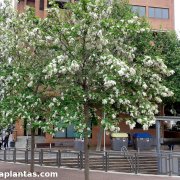Care of the tree Robinia pseudoacacia or Black locust |
|
The genus Robinia, family Fabaceae, comprises 8 species of deciduous trees and shrubs native to Mexico and the US. Some species are: Robinia pseudoacacia, Robinia hispida, Robinia neomexicana, Robinia viscosa. Common names: Black locust, Yellow Locust. This species is native to Eastern North America. They are large, relatively fast-growing trees that reach 30 meters (98.4 feet) in height. They have alternate pinnate leaves that are formed by leaflets with a pair of spines. The white flowers appear in clusters. They bloom in spring. They produce fruits in the form of flat pods. Black locust is used in streets, in public parks and in large gardens; it resists pollution from cities well. Robinia pseudoacacia needs full sun or light shade exposure and a warm climate. The soil must contain organic matter, be well drained and not be chalky. Water moderately, waiting for the substrate to dry. Yellow Locust resists drought but not excess water. Fertilize before planting with manure and a little mineral fertilizer. Robinia pseudoacacia can be attacked by aphids and fusariosis (fungi). Black locust is propagated from seeds sown in spring or by cuttings in late winter. |
Images of the tree Robinia pseudoacacia or Black locust |
Find plants
Robinia pseudoacacia or Black locust | Care and Growing
© 2025 FavThemes





